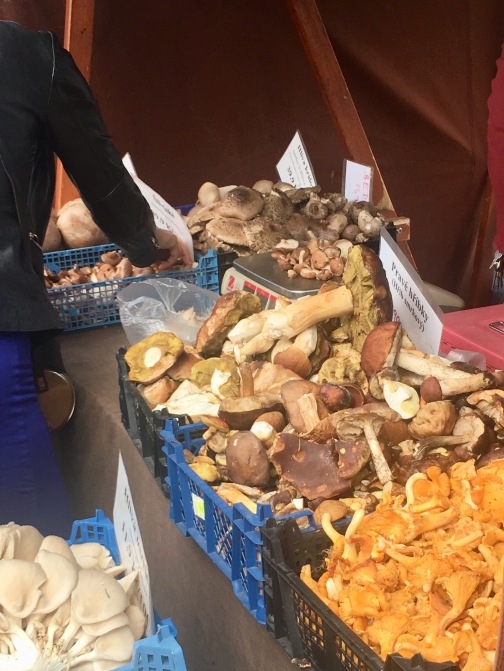I have always been fascinated with the persistence of old practices of eating in cities. We are so accustomed to thinking about urban provisions as something that happens in marketplaces and supermarkets that we rarely notice the households that continue to bake, pickle, can, and smoke their own food products. Even older than these practices are those city dwellers who gather their foods, seasonally, from urban spaces most of us would never think of as sources of edibles.
Back in those romantic days of Counter Culture communes (1965-75), there was an anthropologist (Hawaii 1948) and author of handbooks for gathering wild foods in North America named Ewell Gibbons.

Euell Gibbons
I was reminded of this a few weeks ago, while visiting relatives in Prague. Tom, my second cousin-in-law (Is that a thing?) is an avid mushroom hunter. One Saturday morning, after playing his usual round of tennis down the street, he walked to his secret places in the forested, river ravine preserve in front of his house (He swears he’ll go to his grave without revealing where it is. Except his son knows exactly where tit is, of course. Ah, kinship!), returning home about an hour later with a basket full of fresh-picked, wild mushrooms. I couldn’t identify most of them, but I accepted that they were perfectly edible. After all, Tom had been picking and eating wild mushrooms since he was a boy and he’s my age (i.e. OLD). His wife, Maryla, never flinched. She had been eating whatever he brought home for all the forty-odd years of their marriage. For supper, she made a simple scramble of chopped, sautéed mushrooms and eggs. No herbs, no fancy oils, just salt and black pepper. It wasn’t a pretty dish. Maryla did not scrape off any black gills, as I might, before she chopped the mushrooms. The resulting scramble had a grayish tint. But it was delicious.
Most Europeans today are still deeply enmeshed in the seasonal round of uncultivated foods,even though many of the wild foods have begun to be cultivated to meet the demand. These include fiddle ferns and ramps in the spring, wild strawberries through the early summer, wild mushrooms in the late summer, chestnuts and venison in the late fall. The positive feelings toward seasonality, namely, that “We can eat them now, so let’s do that, because soon the best tasting ones will be gone and we’ll not taste them until next year,” are reflected in agricultural produce as well. Asparagus, cultivated strawberries, potatoes, tomatoes, sweet and chili peppers, gooseberries and currents in high summer, hazelnuts in late summer, wine, lambs and suckling pigs in Spring, ducks and geese in late autumn, All have the reputation for at least having their finest, most refined taste only at certain times of the year. At other times, it is a compromise to eat them. Many choose to forgo such off-season produce in favor of other options. This is really different from the attitude of most city-dwelling North American foodies. I can’t speak for rural dwelling folks there, although hunting in general is a well-know part of how small-town folk in North America represent themselves. But in the cities, the recipe rules. And if the recipe says fresh strawberries, then regardless of whether they have any taste or not, fresh strawberries, flown in from somewhere in the Southern Hemisphere, are purchased and ‘enjoyed.’
 If your European household is not blessed with someone who has a secret forest full of wild mushrooms, all is not lost. All the markets have mushrooms in season. Here is a stand at a farmer’s market that is held every Saturday on the campus of the Technical University, down the street from Tom and Maryla’s house. As you can see, there are lots of healthy looking chanterelles (lower right) and porcini (center), as well as cultivated shiitake (upper right) and oyster (lower left). You can tell the porcini are wild because their edges have been nibbled by little furry forest animals. That’s the sign of authenticity!
If your European household is not blessed with someone who has a secret forest full of wild mushrooms, all is not lost. All the markets have mushrooms in season. Here is a stand at a farmer’s market that is held every Saturday on the campus of the Technical University, down the street from Tom and Maryla’s house. As you can see, there are lots of healthy looking chanterelles (lower right) and porcini (center), as well as cultivated shiitake (upper right) and oyster (lower left). You can tell the porcini are wild because their edges have been nibbled by little furry forest animals. That’s the sign of authenticity!
Let’s face it, most of us city-dwelling foodies are not about to down a plate of pre-nibbled mushrooms. And that is precisely what eating Tom’s mushrooms brought to mind for me. The relationship between people in cities and those aspects of reality that they categorize as nature is an instrumental one. By that I mean that only those aspects of nature that can be controlled (infections and other pests), sanitized (foods and fibers), channeled (water and sewage), regulated (air temperature, velocity, and moisture), or camouflaged (marshlands, deserts, and scrub) are acceptable neighbors. All other ‘inhabitants’ of nature are unwelcome, and certainly to be avoided at all costs. I’ve written about this before with examples of what city engineers do with wild animals who invade neighborhoods (it’s not pretty), and extreme weather events, like hurricanes, tornadoes and wildfires. In such cases, our fears of a world out of balance can only be placated by feats of engineering and logistical marvels that return the status quo ante in a ridiculously short time. WE DECLARE THAT WE WILL NOT SUFFER AT THE HANDS OF NATURE! and if we are forced to do so, we will hold humans accountable for our pain.
I’m still working out the implications of this particular view of nature held by many urbanites, even if it is only spoken of when the going gets tough. I suspect it is only one of several views that are available depending on the context. Like I said, it’s still a work in progress. Watch this space.
Good article. Some of us still follow Euell Gibbons and pick wild mushrooms and plants and harvest shellfish and fish in New England.
LikeLike